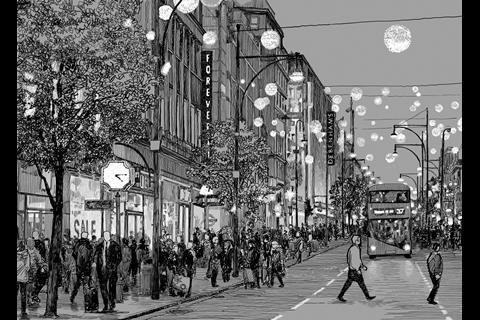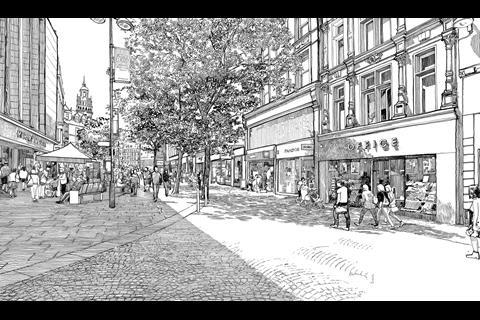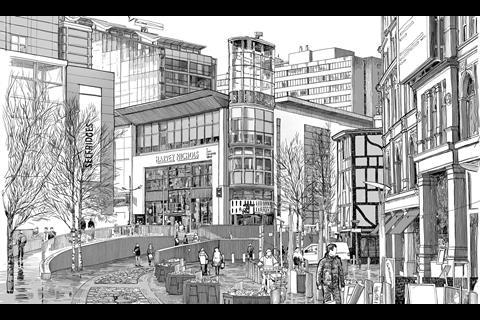A new book on high streets invites us to see the retail crisis in a different light, and seek out innovative ways to reinvent our urban centres, writes Jennie Savage

High Street weaves a complex tapestry of stories. It traces personal endeavour, recalling the lives of entrepreneurs who took risks and put skin in the game, who were celebrated locally and whose legacy made town centres unique. These rich narratives are laid out alongside affect, identifying how policy and centralised decision making have manifested through the lens of the local.
This oscillation of scale and time builds a picture, or the sense, that high streets are a living archive, indelibly linked to the local. High streets are places where the macro and the micro story become visible, where we experience culture and where ‘nowness’ has currency. They are the keepers of stories, places that are fixed in cultural memory, often perceived as static and timeless.
What the book shows us is that in fact these are places in constant flux, part of a never ending and evolving conversation. Rather than being fixed entities, high streets are porous and light footed, able to respond to and reflect the latest fashion and broader trend whether that be economic, political or other.
High Street is beautifully written and illustrated. It is meticulously researched. A compendium of histories which turn high streets inside out and show them to be fragile-places that are simply the end point of fallible decision-making processes, and at the same time, timeless and resilient. They have one foot in deep histories of human society – legacies of ‘the camp fire’ or town water pump, meeting places of exchange, market-places, places that have shaped who we are as a culture.
Their other foot is in the future… they shape who we become. From shopping trips with our mothers and venturing into town as teenagers, our high streets give us the freedom to find identity, purpose, community. They eased us into music and fashion and give us the freedom to choose which version of ourselves to become.
The first sections set out the thesis of the book, providing examples from Manchester and Sheffield to Guilford, Stroud or Ludlow, giving the reader insight into the ebb and flow of a hundred versions of high streets from across the UK. What these examples tell us is that we must not see high streets as one fixed entity but a series of multiplicities that weave across and through time, that iterate the local whilst simultaneously bringing centralised decision making, political thought and, of course, the will of the market, to bear.
The team who put this project together have picked up threads and followed them. They forensically examine the big picture, tracing the developments of supermarkets, shopping malls and noting the impact of these macroeconomic shifts on local places. Facts and figures, distribution points and business models, commodity fetishism and materiality, or indeed the move to de-materiality through the evolution from, (for example) vinyl record to Spotify (and indeed back to vinyl) are explored in an interesting way through the inter-generational and gendered experience of the writers.
High Street makes the high street personal, and it reminds us that these centres serve a much greater purpose than renting shops and flogging stuff.
For better or worse our connection to culture in the 20th century was a material one. It is something we bought into, not only through physically purchasing and taking it home, but through the tactile and physical experience of being there in that space – of choosing, browsing and buying.
Now in the first quarter of the 21st century we have moved into a digital world where experience and identity, and private spaces of home are commodified and sold through the dark arts of social media and the murky world of algorithms and influencers. The emptying town centres up and down the country bear the hallmarks of austerity and economic deprivation. They continue to be spaces that reflect contemporary culture – even when that is uncomfortable.
High Street asks the critical question: How our town centres can bounce back from the retail crisis?
The final section of the book looks at the ‘Future High Street’. Taking the threads that had been traced backward to establish ‘history’ in the first section of the book, the team throw these threads forward, into the future and follow them to see what they become.
This book tells us that what we are experiencing reflects ‘nowness’ itself and that we must look to innovation to sow the seeds of change
Again, through looking at the detail the team find seeds of recovery, glimmers of hope, places where innovation shows us what the future of high streets might look like through examples of design interventions in places where they are already starting to bounce back.
Crucially, this book helps the reader to see this ‘crisis’ in a different light – how high streets are doing exactly what our town centres have always done, which is to reflect society at large, to show us who we are.
That our high streets are undergoing traumatic changes is simply a reflection of broader ruptures – of living through a paradigm shift where capitalism is becoming intangible and de-materialised. And that this current moment is an invitation to re-imagine and re-make civic life whilst holding in mind the climate crisis and inevitable impact that must have on society in terms of mitigating risk and inspiring hope.
This book tells us that what we are experiencing reflects ‘nowness’ itself and that we must look to innovation to sow the seeds of change. High Street maps a new set of directions to align future high streets with broader aspirations, hopes and dreams. Indeed Walter Benjamin, in his expansive Arcades Project describes how each epoch dreams the one to follow.
This book shows us that the high street is not in crisis.
Furthermore, it sets the challenge to dream something new. That this current moment is an opportunity to set aside systems that no longer serve us and create spaces to embody who we wish to be. And to let us dream a hopeful, beautiful, collaborative dream that serves the many, that celebrates local difference and that benefits everyone.
Postscript
High Street: How our town centres can bounce back from the retail crisis, by David Rudlin, Vicky Payne & Lucy Montague, is publish by RIBA Publishing.
Jennie Savage is a writer, artist and urban designer.




















1 Readers' comment